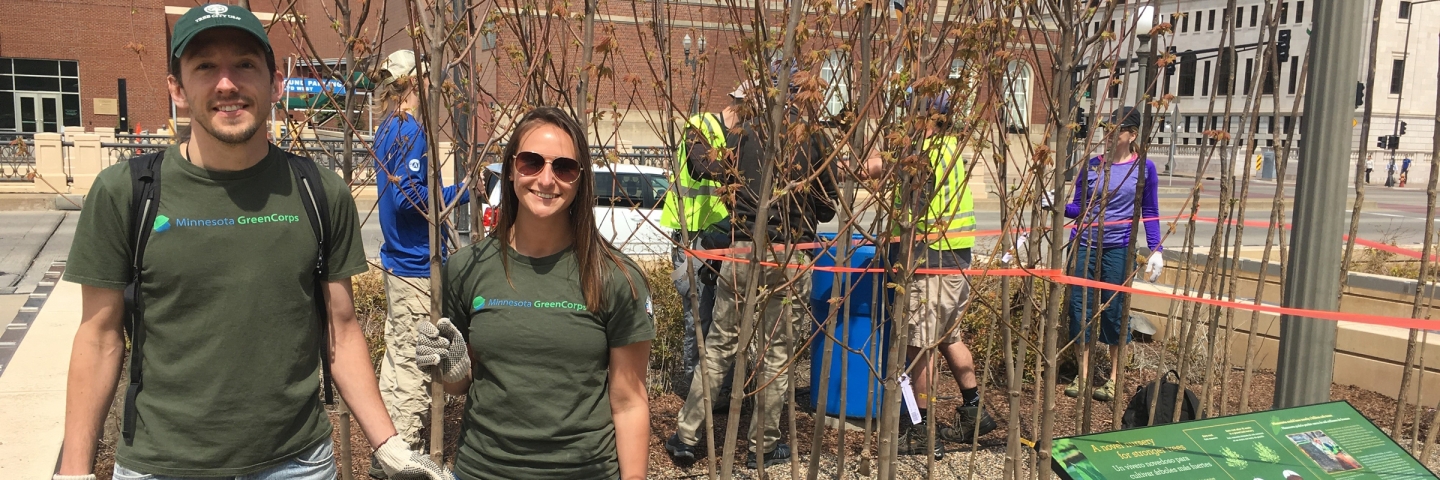The Minnesota GreenCorps program, coordinated by the MPCA, aims to preserve and protect Minnesota’s environment while training a new generation of environmental professionals.
Each year, the program places AmeriCorps members with host site organizations around the state to help communities increase resilience to climate change by:
- reducing solid waste and increasing recycling.
- reducing greenhouse gases and other air pollutants.
- reducing water runoff and improving water quality.
- encouraging eco-friendly behavior.
- reducing disproportionate negative impacts from pollution.
Members serve full-time at their host sites for 11 months, from mid-September through mid-August.
Minnesota GreenCorps members educate community members and youth, coordinate multi-modal transportation events, remove invasive species, plant trees, install rain gardens, benchmark energy, conduct waste sorts, inventory trees, and more. These projects increase the resilience of Minnesota communities from the impacts of climate change.
MN GreenCorps members
Serve a community, address critical environmental issues, and develop green job skills as a Minnesota GreenCorps member!
Each member serves on a project in one of four topic areas:
- community readiness and outreach
- energy conservation and green transportation
- stormwater and forestry
- waste reduction and recycling
Members earn a living allowance, health insurance, mental health services with counseling, student loan forbearance on eligible loans, and an education award for education expenses or qualified student loans. Members receive training from the MPCA, develop green job skills, gain professional experience, network with environmental professionals, and are paired with a mentor who provides ongoing guidance.
The member application is anticipated to open in early May!
Host sites
Organizations eligible to host Minnesota GreenCorps members include local, regional, state, and tribal government entities; school districts; public education institutions; and 501(c)(3) nonprofits.
As a host site, your organization can harness a member's energy and enthusiasm to move your environmental projects forward. Host sites don't pay a fee to participate in the program but are expected to provide supervision, office space, internet and phone service, training, and any resources necessary for members to accomplish their projects. The MPCA manages the recruitment, application, and selection process for Minnesota GreenCorps members.
The MPCA is not currently accepting host site applications. We anticipate accepting applications from February through mid-March each year, with the program starting in mid-September. Sign up to be notified when the next application period opens.
Program impact
Members address critical environmental issues through projects such as retrofitting public buildings to save energy, improving public lands, educating community members, preventing waste, and recycling or composting. In addition, Minnesota GreenCorps members engage volunteers in hands-on projects to help communities build their capacity for environmental stewardship and resilience to climate change.
See how the Minnesota GreenCorps program is building organizational capacity and improving communities:
Follow us!
Follow Minnesota GreenCorps on social media to get updates on the program. See members in action and learn more about the impacts the program has on communities throughout Minnesota.
Partners and funding
Minnesota GreenCorps is an AmeriCorps program. Funding is provided through a grant from ServeMinnesota, AmeriCorps, and the MPCA. Participating host site organizations also provide in-kind resources.
- AmeriCorps is a federal agency that engages Americans in service to meet critical needs in education, the environment, public safety, health, veterans’ services, and economic opportunity. The mission of AmeriCorps is to improve lives, strengthen communities, and foster civic engagement through service and volunteering.
- ServeMinnesota is the state commission for all AmeriCorps programs in Minnesota, including Minnesota GreenCorps.


